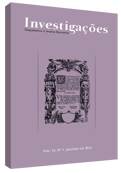La maladie de la mort é a doença da morte? (Um questionamento à equivalência na tradução)
Abstract
Neste artigo busca-se fazer um questionamento sobre um dos mais difundidos e controversos conceitos no universo da tradução: a equivalência. Será, realmente, a atividade tradutória uma questão de equivalência entre duas línguas na transmissão de um dado conteúdo? Reflete-se, pois, sobre as ideias lançadas por estudiosos da teoria da tradução (alguns deles também tradutores) como Jean-Paul Vinay, Eugene Nida, Danica Seleskovich, Maurice Pergnier e Eugênio Coseriu, especificamente sobre as noções de equivalência que tais autores trabalham: suas limitações, suas conexões com a prática tradutória. E busca-se, por fim, mas não com menor relevância, ilustrar a discussão pela aplicação de tais ideias à edição bilíngue de La Maladie de la mort, de Marguerite Duras.References
AUDEN, W. H. 2003. A Mão do artista. São Paulo: Siciliano.
COSERIU, Eugênio. 1982. O Homem e sua linguagem. Rio de Janeiro: Presença.
DURAS, Marguerite. 1987. A Doença da morte. Rio de Janeiro: Taurus. (ed bilíngue)
JAKOBSON, Roman. 1990. Línguística e comunicação. São Paulo: Cultrix.
NIDA, Eugene A. 1993. Language, culture and translating. Shanghai Foreign Language Education Press.
PERGNIER, Maurice. 1976. L’Envers des mots, in: Études de linguistique appliquée. Sèrie 24, octobre-decembre, Paris: Didier, p.92-126.
SELESKOVITCH, Danica. 1976. Traduire : de l’experience aux concepts, in: Études de linguistique appliquée. Sèrie 24, octobre-decembre, Paris: Didier, p. 64-91.
VINAY, Jean-Paul. 1968. La Traduction humaine, in: Le Langage. Paris: Gallimard.
Downloads
Published
How to Cite
Issue
Section
License
Copyright (c) 2011 Renata Pimentel

This work is licensed under a Creative Commons Attribution 4.0 International License.
Authors who publish with Revista Investigações agree to the following terms:
Authors retain copyright and grant the journal right of first publication with the work simultaneously licensed under the Creative Commons Attribution 4.0 International (CC BY 4.0) license that allows others to share the work with an acknowledgement of the work's authorship and initial publication in this journal.
Authors are able to enter into separate, additional contractual arrangements for the non-exclusive distribution of the journal's published version of the work (e.g., post it to an institutional repository or publish it in a book), with an acknowledgement of its initial publication in this journal.
You are free to:
Share — copy and redistribute the material in any medium or format for any purpose, even commercially.
Adapt — remix, transform, and build upon the material for any purpose, even commercially.
The licensor cannot revoke these freedoms as long as you follow the license terms.
Under the following terms:
Attribution — You must give appropriate credit , provide a link to the license, and indicate if changes were made . You may do so in any reasonable manner, but not in any way that suggests the licensor endorses you or your use.
No additional restrictions — You may not apply legal terms or technological measures that legally restrict others from doing anything the license permits.

